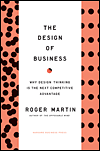When I was 13 years old, I decided that I wanted to study architecture in college. For me it seemed an obvious choice. Growing up in Tokyo, I was constantly surrounded by design from the most subtle, how your food is prepared and presented to the the more monolithic - great architecture. However, during my final two years of architecture school, I realized that while I loved the study of architecture, I wasn't so sure about the practice. Having gone to architecture school during a recession, also made me question the surety of my degree. I witnessed many architects get laid off from architecture firms they had dedicated their lives to. So in graduate school, given that I was always interested in the factors that influenced design, I decided to sit in a few MBA classes. I was going to figure out how business influenced design.

To make a short story, shorter, I eventually ended up working for two huge global consulting firms. One of which hailed Six Sigma and number crunching as the holy grail. Conclusions on consulting projects, even if it involved a study on less predictable factors like human behavior in a work environment were reduced to no more than excel charts. As a designer, I watched daily innovation and creativity die. Where was someone like me, a hybrid, a trained architect with a penchant for business development and strategy to go?
In the past few years however, there has been a lot of new research from various business leaders, academics and practitioners on the value of design thinking. Business thinkers like Roger Martin are advocating design thinking as strategy for companies to be more competitive, innovative and flexible.
For years now, scholars like Richard Florida and Charles Landry have been writing and consulting with governments all around the world on the rise of the creative class and the growing importance of creative professionals as economic drivers in city development. Design thinking however, takes that concept to another level.
But what exactly is design thinking? Basically it is thinking and analysis with the mindset and sensibility of a designer. Instead of solely relying on deductive and inductive logic as most business people do, designers draw more from abductive reasoning. According to Roger Martin, "A person or organization instilled with that discipline is constantly seeking a fruitful balance between reliability and validity, between art and science, between intuition and analytics, and between exploration and exploitation. The design-thinking organization applies the designer's most crucial tool to the problems of business. That tool is abductive reasoning." Martin says that large organizations and businesses often lose sight of the creativity that made them successful. Too often, before a new program or product can be implemented, leaders want proof of their success in advance and so the past is often extrapolated to determine future successes. This is the surest way to stifle creativity and innovation. Conversely, he argues, the way a designer works is to imagine a future that does not yet exist and that imagination is the advan
 tage a designer brings. Ultimately, you make your own reality.
tage a designer brings. Ultimately, you make your own reality.In a world of global outsourcing, Daniel Pink has drawn a similar conclusion on the competitive advantage design thinking brings to companies. In his book A Whole New Mind, published in 2005, Pink writes, "Design is a high-concept aptitude that is difficult to outsource or automate - and that increasingly confers a competitive advantage in business."
The process of design and design thinking has over the years gained such prominence that in 2006 it became part of the agenda at the World Economic Forum in Davos.
These new developments and research are also filtering their way down to how business schools teach. Rotman School of Management at University of Toronto has paired up with the Ontario College of Arts to offer courses that link business strategy with design thinking. Stanford University launched the Hasso Plattner Institute of Design in 2005 to teach design thinking. The University of California, Berkeley offers a MBA course that brings together students from the Haas School of Business and California College of Arts. Suffolk University in Boston offers an executive MBA with a concentration in Design Management. This is not uniquely an American phenomenon, there are business schools around the world that are altering their curriculum accordingly. INSEAD in France has paired with Art Center College of Design in Los Angeles to offer a joint MBA/design degree. The Helsinki School of Economics and the University of Art and Design in Helsinki now offer a joint program in International Design Business Management. And the list goes on....
For someone who has spent much of her professional career trying to convince companies of the versatility and breadth of a design background - this is music to my ears. It sounds like sweet redemption.

























